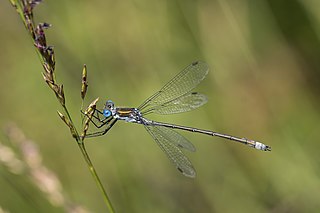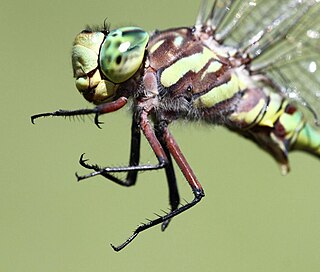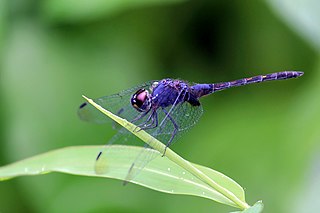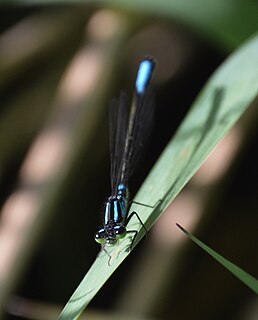
The black-tailed skimmer is a dragonfly belonging to the family Libellulidae.

The blue-eyed darner is a dragonfly of the family Aeshnidae.
Palaemnema is a genus of dragonflies in the family Platystictidae. They are commonly known as shadowdamsels and are found in the New World, from Arizona to Peru and French Guiana.

The ebony jewelwing is a species of broad-winged damselfly. One of about 150 species of Calopterygidae, it is found in the eastern U.S. and southeastern Canada, ranging west to the Great Plains. Other common names include black-winged damselfly.

The double-striped bluet is species of damselfly in the family Coenagrionidae. This species grows to lengths 21–28 mm. Its common name from the peculiar black shoulder stripe, which is divided in two by a thin blue stripe. This is the key identification characteristic; no other damselfly has a shoulder stripe that looks like this one.

Esme longistyla is damselfly in the family Platycnemididae. It is commonly known as the Nilgiri bambootail. It is endemic to Western Ghats in India.

Eastern forktail is a member of the damselfly family Coenagrionidae.

Lestes sponsa, is a damselfly, with a wide Palaearctic distribution. It is known commonly as the emerald damselfly or common spreadwing. Both males and females have a metallic green colour and when resting its wings are usually half opened.

Austrolestes colensonis, commonly known as the blue damselfly, is a species of damselfly of the family Lestidae. It is endemic to New Zealand and can commonly be found throughout the country. It is New Zealand's largest damselfly. A. colensonis is usually seen close to fresh water between the months of October to May but is most abundant in January.

Pinheyschna subpupillata, the stream hawker, is a species of dragonfly in the family Aeshnidae.

The black stream glider, indigo dropwing is a species of dragonfly in the family Libellulidae. It is a very widespread species, occurring from Greece, Cyprus and Turkey, throughout Asia to New Guinea.
Proischnura polychromatica, the mauve bluet, is a small species of damselfly in the family Coenagrionidae. It is endemic to a small area of Cape Province in South Africa. The adult male has a mauve sheen to its dark-coloured body, a bronze-green thorax striped with mauve, and a pale brown abdomen with a bronze-green dorsal stripe. The female is mainly pale brown. The natural habitat of this damselfly is transient pools in stream beds with floating vegetation, especially sedges. Although previously more widespread, it is now known from a single location where it is threatened by the encroachment of cattle and the loss of suitable habitat. For these reasons, the International Union for Conservation of Nature has rated it as "endangered".

Ischnura erratica, the swift forktail, is a species of damselfly in the family Coenagrionidae. It is native to the Pacific Northwest, ranging from British Columbia to northern California.
Neoneura amelia, commonly known as Amelia's threadtail, is a species of damselfly in the family Protoneuridae. It is native to the southern United States and Central America, its range extending from the southern tip of Texas to Panama.

Dysphaea ethela, black torrent dart, is a species of damselfly in the family Euphaeidae. The insect is named after Frederic Charles Fraser's wife, a constant companion of his collecting trips in India.

Euphaea cardinalis, Travancore torrent dart, is a species of damselfly in the family Euphaeidae.
Acanthagrion quadratum, or Mexican Wedgetail, is a pond damselfly, of the family Coenagrionidae. It was first identified by Edmond de Sélys Longchamps, in 1876.

Indosticta deccanensis, saffron reedtail is a damselfly species in the family Platystictidae. It is endemic to Western Ghats in India.















